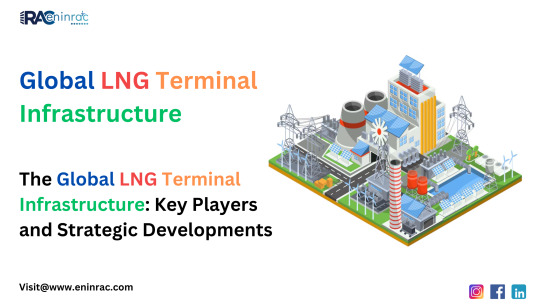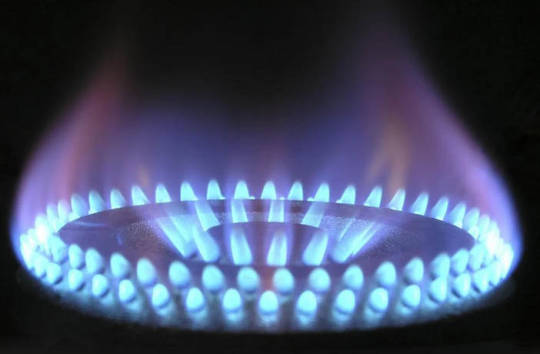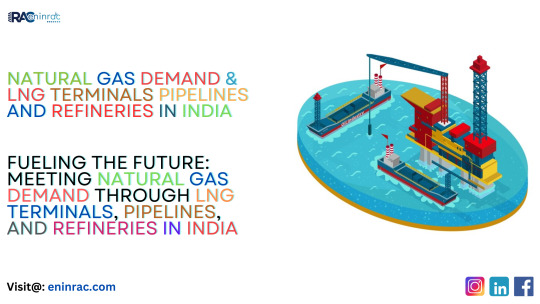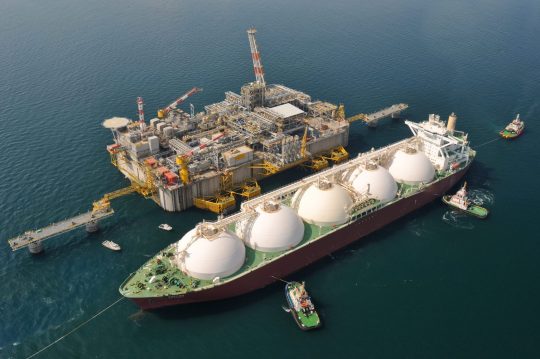#LNG Terminal
Explore tagged Tumblr posts
Text
DELRAY BEACH, Fla., June 6, 2025 /PRNewswire/ -- The global LNG Terminals Market is anticipated to grow from estimated USD 7.86 billion in 2025 to USD 13.15 billion by 2030, at a CAGR of 10.9% during the forecast period. The LNG Terminals Market is shaped by the growing demand for cleaner, flexible energy sources, driven by global carbon neutrality goals and heightened energy security concerns. As LNG offers a less carbon-intensive and scalable alternative to coal and oil, it is becoming a key transitional fuel. This shift has accelerated the construction of liquefaction terminals in exporting countries and regasification terminals in importing regions, notably in Asia Pacific, Europe, and South America. Supportive government policies, favorable regulations, and long-term energy strategies are further attracting investment. Additionally, environmental goals encourage the integration of low-carbon technologies, such as operational electrification and emissions reduction systems, into terminal design, spurring innovation and long-term market growth.
0 notes
Text
The Global LNG Terminal Infrastructure: Key Players and Strategic Developments
Explore the dynamic landscape of Global LNG Terminal Infrastructure, highlighting the critical role of LNG Infrastructure in meeting global energy demands. Discover the significance of LNG Terminals in facilitating the storage and regasification of LNG, and learn about leading LNG Companies driving innovation and growth in the sector. This overview provides valuable insights into the strategic developments shaping the future of LNG and its infrastructure globally.

0 notes
Text
LNG Fuelling Station Market Key Players, End User Demand and Analysis Growth Trends by 2032
The LNG (liquefied natural gas) fueling station market has been experiencing significant growth in recent years. LNG is a cleaner-burning fuel compared to traditional petroleum-based fuels, making it an attractive option for various applications, especially in the transportation sector. Here's an overview of the LNG fueling station market:
Report Description:
Attribute
Description
Market Size
Revenue (USD Billion)
Market size value in 2022
USD 8.1 billion
Market size value in 2032
USD 17.3 billion
CAGR (2023 to 2032)
7.9%
Market Drivers:
Environmental Regulations: Stricter emission standards and regulations to reduce greenhouse gas emissions have driven the adoption of cleaner fuels like LNG.
Cost-Effectiveness: LNG can offer cost advantages over diesel and gasoline, particularly in regions where natural gas is abundant and relatively inexpensive.
Energy Security: LNG provides an alternative fuel source, reducing dependence on imported oil and enhancing energy security.
Technological Advancements: Developments in LNG storage and handling technologies have made the construction and operation of LNG fueling stations more feasible and efficient.
Applications:
Heavy-Duty Vehicles: LNG is commonly used as a fuel for long-haul trucks, buses, and other heavy-duty vehicles, offering extended driving ranges and reduced emissions.
Marine Transportation: LNG is increasingly being used as a fuel for ships, including cargo vessels and ferries, due to its environmental benefits and compliance with stricter marine emission regulations.
Industrial Sector: LNG fueling stations are also utilized in industries where natural gas is a primary energy source, such as mining, manufacturing, and power generation.
Market Outlook:
Growing Infrastructure: Governments and private companies are investing in the development of LNG infrastructure, including fueling stations, to support the expanding demand for LNG as a transportation fuel.
Regional Expansion: LNG fueling stations are being established in various regions globally, with significant growth observed in North America, Europe, and Asia-Pacific.
Collaborations and Partnerships: Energy companies, fuel station operators, and vehicle manufacturers are forming strategic alliances to promote the adoption of LNG and accelerate the expansion of LNG fueling station networks.
Technological Innovations: Ongoing research and development efforts are focused on improving LNG storage and distribution technologies, enhancing station efficiency, and exploring the potential of liquefied biogas (LBG) as a renewable alternative to LNG.
Challenges:
Initial Infrastructure Costs: Establishing LNG fueling stations requires significant upfront investment, including storage tanks, dispensers, and safety measures, which can be a barrier to market entry.
Limited Market Awareness: Despite the environmental and economic advantages, there is still a need for greater awareness and education about LNG as a viable fuel option.
Regulatory Support: Governments can play a crucial role by providing supportive policies, incentives, and regulations that promote the adoption of LNG and facilitate the growth of the fueling station infrastructure.
Several key factors contribute to the growth and development of the LNG fueling station market. These factors include:
1.Environmental Regulations and Policies: Stricter regulations aimed at reducing greenhouse gas emissions and promoting cleaner fuels have been a significant driver for the adoption of LNG as a transportation fuel. Governments and regulatory bodies are implementing policies and incentives to encourage the development of LNG infrastructure, including fueling stations.
2.Cost and Fuel Price Stability: LNG can provide cost advantages over traditional petroleum-based fuels, particularly in regions where natural gas is abundant and competitively priced. The stability of natural gas prices compared to the volatility of oil prices also makes LNG an attractive option for fleet operators and industries seeking fuel cost predictability.
3.Energy Security and Diversification: LNG offers an opportunity for countries to enhance their energy security by diversifying their fuel sources. This is particularly relevant for countries that have significant domestic natural gas resources but rely heavily on imported oil.
4.Advancements in LNG Technology: Technological advancements in LNG storage, transportation, and dispensing have made the construction and operation of fueling stations more efficient and cost-effective. Improved cryogenic storage tanks, vaporization systems, and dispensing equipment have contributed to the expansion of the LNG fueling infrastructure.
5.Increasing Adoption in Transportation Sector: The transportation industry, including heavy-duty vehicles and marine vessels, is increasingly adopting LNG as a fuel due to its lower emissions profile compared to diesel or gasoline. This demand from the transportation sector is driving the need for more LNG fueling stations to support the growing fleet of LNG-powered vehicles.
These key factors, along with ongoing technological advancements and supportive government policies, are expected to continue driving the growth of the LNG fueling station market in the coming years.
We recommend referring our Stringent datalytics firm, industry publications, and websites that specialize in providing market reports. These sources often offer comprehensive analysis, market trends, growth forecasts, competitive landscape, and other valuable insights into this market.
By visiting our website or contacting us directly, you can explore the availability of specific reports related to this market. These reports often require a purchase or subscription, but we provide comprehensive and in-depth information that can be valuable for businesses, investors, and individuals interested in this market.
“Remember to look for recent reports to ensure you have the most current and relevant information.”
Click Here, To Get Free Sample Report: https://stringentdatalytics.com/sample-request/lng-fuelling-station-market/2734/
Market Segmentations:
Global Electrical Bushings Market: By Company • ABB • Siemens • GE • Eaton • Nexans • Bharat Heavy Electricals Limited • CG Power and Industrial Solutions • Elliot Industries • Gamma • Gipro GmbH • Hubbell • Polycast International • RHM International • Toshiba • Webster-Wilkinson Global Electrical Bushings Market: By Type • Oil Impregnated Paper (OIP) • Resin Impregnated Paper (RIP) • Others Global Electrical Bushings Market: By Application • Utilities • Industries • Others Global Electrical Bushings Market: Regional Analysis All the regional segmentation has been studied based on recent and future trends, and the market is forecasted throughout the prediction period. The countries covered in the regional analysis of the Global Electrical Bushings market report are U.S., Canada, and Mexico in North America, Germany, France, U.K., Russia, Italy, Spain, Turkey, Netherlands, Switzerland, Belgium, and Rest of Europe in Europe, Singapore, Malaysia, Australia, Thailand, Indonesia, Philippines, China, Japan, India, South Korea, Rest of Asia-Pacific (APAC) in the Asia-Pacific (APAC), Saudi Arabia, U.A.E, South Africa, Egypt, Israel, Rest of Middle East and Africa (MEA) as a part of Middle East and Africa (MEA), and Argentina, Brazil, and Rest of South America as part of South America
Visit Report Page for More Details: https://stringentdatalytics.com/reports/electrical-bushings-market/2719/
Reasons to Purchase Electrical Bushings Market Report:
• To obtain insights into industry trends and dynamics, including market size, growth rates, and important factors and difficulties. This study offers insightful information on these topics.
• To identify important participants and rivals: This research studies can assist companies in identifying key participants and rivals in their sector, along with their market share, business plans, and strengths and weaknesses.
• To comprehend consumer behaviour: these research studies can offer insightful information about customer behaviour, including preferences, spending patterns, and demographics.
• To assess market opportunities: These research studies can aid companies in assessing market chances, such as prospective new goods or services, fresh markets, and new trends.
• To make well-informed business decisions: These research reports give companies data-driven insights that they may use to plan their strategy, develop new products, and devise marketing and advertising plans.
In general, market research studies offer companies and organisations useful data that can aid in making decisions and maintaining competitiveness in their industry. They can offer a strong basis for decision-making, strategy formulation, and company planning.
Click Here, To Buy Premium Report: https://stringentdatalytics.com/purchase/electrical-bushings-market/2719/?license=single
About US:
Stringent Datalytics offers both custom and syndicated market research reports. Custom market research reports are tailored to a specific client's needs and requirements. These reports provide unique insights into a particular industry or market segment and can help businesses make informed decisions about their strategies and operations.
Syndicated market research reports, on the other hand, are pre-existing reports that are available for purchase by multiple clients. These reports are often produced on a regular basis, such as annually or quarterly, and cover a broad range of industries and market segments. Syndicated reports provide clients with insights into industry trends, market sizes, and competitive landscapes. By offering both custom and syndicated reports, Stringent Datalytics can provide clients with a range of market research solutions that can be customized to their specific needs
Contact US:
Stringent Datalytics
Contact No - +1 346 666 6655
Email Id - [email protected]
Web - https://stringentdatalytics.com/
#LNG#Fuelling Station#Natural Gas#Alternative Fuel#LNG Infrastructure#LNG Vehicles#Energy Industry#Transportation#Fueling Infrastructure#LNG Terminal#LNG Storage#LNG Distribution#LNG Supply Chain#LNG Fueling Technology#LNG Fueling Equipment#Environmental Sustainability#Clean Energy#Renewable Energy#Greenhouse Gas Emissions#LNG Market#LNG Demand#LNG Industry#LNG Infrastructure Development.
0 notes
Text
Robbensterben vor Rügen: Politik und Medien ignorieren möglichen Zusammenhang mit LNG-Terminal
Die Ostsee hat binnen weniger Wochen 40 tote Robben an den Strand der Insel Rügen gespült. Ausgerechnet dort befindet sich das neue LNG-Terminal, das kürzlich ohne Umweltprüfung an den Start ging. Doch prüfen, ob beides miteinander zu tun haben könnte, will man auch jetzt nicht. Von Susan Bonath Seit Wochen spült die Ostsee tote Kegelrobben an den Oststrand der Insel Rügen, bisher offenbar 40…
0 notes
Text
The Role of FSRUs in Expanding LNG Terminals in India
India's energy demand has been steadily rising, and natural gas has emerged as a key player in meeting this demand due to its cleaner-burning properties. To support the country’s growing reliance on Liquefied Natural Gas (LNG), Floating Storage Regasification Units (FSRUs) are playing a pivotal role. FSRUs have revolutionized the LNG terminals in India supply chain, allowing for quicker and more flexible deployment of LNG infrastructure.
What Are FSRUs?
FSRUs act as floating LNG import terminals, offering both storage and regasification capabilities. This makes them a cost-effective and faster alternative to traditional onshore LNG terminals. One of the major advantages of FSRUs is their mobility, which allows for flexible location changes based on demand and other strategic requirements. In India, where natural gas infrastructure is still developing, FSRUs are helping to bridge the gap, ensuring the steady supply of LNG to various regions.
Growth of LNG Terminals in India
India has been actively expanding its LNG import infrastructure to diversify energy sources. The country currently has several LNG terminals, with plans to further increase capacity in the coming years. Alongside land-based terminals, FSRUs are playing a crucial role in ensuring energy security and meeting demand in areas where constructing permanent infrastructure may not be viable.
To learn more about India’s strategic advancements in the oil and gas sector, including LNG terminals, visit Swan Energy’s Oil & Gas division.
Why FSRUs Are the Future
The flexibility, cost-efficiency, and quicker setup times of FSRUs make them the future of LNG terminals in India. As the government pushes for cleaner fuel adoption, FSRUs provide a reliable and scalable solution to meet immediate energy demands. Additionally, these units can be deployed to various coastal regions, ensuring LNG availability across the nation without the lengthy construction process associated with traditional terminals.
India's growing network of LNG terminals and the increasing use of FSRUs highlight the country’s commitment to sustainable energy solutions. This transition not only reduces dependence on coal but also aligns with global efforts to combat climate change.
Read more…
0 notes
Text
0 notes
Text

Torpediert Wirtschaftsministerium eigene Klimaziele?
LNG Wahnsinn schafft dauerhaft neue Abhängigkeiten
Zu diesem Schluss kann man kommen, wenn man die Pläne und die aktuellen Schritte für den Bau von LNG Terminals untersucht. Die taz schreibt: "Und nun baut ausgerechnet das grün geführte Klimaministerium eine LNG-Infrastruktur auf. Die fertigen und geplanten LNG-Kapazitäten belaufen sich im Mittel auf 73 Milliarden Kubikmeter. Das ist ein Drittel mehr Erdgas, als Deutschland einst aus Russland bezog."
Ausgerechnet LNG Gas soll importiert werden, das in der Energiebilanz so viel schlechter da steht als Pipeline Gas. Um das Gas auf Schiffen tranportieren zu können, muss das geförderte Erdgas auf unter minus 161 Grad Celsius abgekühlt werden. Als Flüssigkeit braucht es dann nur ein Sechshundertstel so viel Platz wie das Gas. Für das Abkühlen muss viel Eneergie aufgewendet werden, auch das wieder Verflüssigen wird maschinell unter Energieeinsatz beschleunigt, damit die Schiffe nicht zu lange an den Terminals liegen. Dabei wird im besten Fall nur das umliegende Meerwasser als Wärmetauscher und "ein wenig" elektrische Pumpleistung aufgewendet. Im Ergebnis stellte das Bundesumweltministerium dazu fest, flüssiges LNG, also mit dem Schiff angeliefertes Erdgas, bringe "im Vergleich zur Kohle in der Regel keine Treibhausgasminderung mit sich".
Zur schlechteren Energiebilanz im Vergleich zum Pipeline Gas kommt noch die verheerende Klimabilanz als fossiler Energieträger - den man ja eigentlich abschaffen oder zumindest zurückdrängen wollte. Nun werden LNG Terminals gebaut und im Besitz der Bundesregerung betrieben, weil niemand da war, der das Risiko tragen wollte und den Steuerzahler Milliarden kosten wird. Die Terminals sind mit Ausnahme von Lubmin für 15-20 Jahre beantragt. In Lubmin soll die Anlage dauerhaft betrieben werden. Dabei will die Bundesregierung bis 2045 klimaneutral sein ...
Nebenbei kann man in dem Artikel der taz noch erfahren, dass die LNG-Einkaufspolitik der deutschen Energiekonzerne dazu geführt hat, dass diese nun langfristige Lieferverträge mit US Firmen abschließen, die diese erst dazu bringen z.B. das Plaquemines-Terminal südlich von New Orleans sowie das Terminal Calcasieu Pass 2 (aus-) zu bauen. "Beides sind Hafenprojekte, die überhaupt erst durch solch langfristige Abnahmeverträge wie mit EnBW für Venture Global wirtschaftlich interessant werden."
Wir bezahlen also den klimaschädlichen Ausbau der LNG Wirtschaft nicht nur hier im Lande, sondern fördern diese Technologie auch noch in den USA ...
Mehr dazu bei https://taz.de/Fossile-Politik/!5983492/
Kategorie[21]: Unsere Themen in der Presse Short-Link dieser Seite: a-fsa.de/d/3yi Link zu dieser Seite: https://www.aktion-freiheitstattangst.org/de/articles/8644-20240108-torpediert-wirtschaftsministerium-eigene-klimaziele.html
#Umwelt#Klima#LNG#Terminals#Energiebilanz#Wirtschaft#Klimaschutzgesetz#klimaneutral2045#Kosten#dauerhaft#Transparenz#Informationsfreiheit#Verhaltensänderung
1 note
·
View note
Text
Things Biden and the Democrats did, this week.
January 19-26 2024
The Energy Department announced its pausing all new liquefied natural gas export facilities. This puts a pause on export terminal in Louisiana which would have been the nation's largest to date. The Department will use the pause to study the climate impact of LNG exports. Environmentalists cheer this as a major win they have long pushed for.
The Transportation Department announced 5 billion dollars for new infrastructure projects. The big ticket item is 1 billion dollars to replace the 60 year old Blatnik Bridge between Superior, Wisconsin, and Duluth, Minnesota which has been dangerous failing since 2017. Other projects include $600 million to replace the 1-5 bridge between Vancouver, Washington, and Portland, Oregon, $427 million for the first offshore wind terminal on the West Coast, $372 million to replace the 90 year old Sagamore Bridge that connects Cape Cod to the mainland,$300 million for the Port of New Orleans, and $142 million to fix the I-376 corridor in Pittsburgh.
the White House Task Force on Reproductive Healthcare Access announced new guidance that requires insurance companies must cover contraceptive medications under the Affordable Care Act. The Biden Administration also took actions to make sure contraceptive medications would be covered under Medicare, Medicaid, CHIP, and Federal Employee Health Benefits Program. HHS has launched a program to educate all patients about their rights to emergency abortion medical care under the Emergency Medical Treatment and Labor Act. This week marks 1 year since President Biden signed a Presidential Memorandum seeking to protect medication abortion and all federal agencies have reported on progress implementing it.
A deal between Democrats and Republicans to restore the expand the Child Tax Credit cleared its first step in Congress by being voted out of the House Ways and Means Committee. The Child Tax Credit would affect 16 million kids in the first year and lift 400,000 out of poverty. The Deal also includes an expansion of the Low-Income Housing Tax Credit which will lead to 200,000 new low income rental units being built, and also tax relief to people affected by natural disasters
The Senate Foreign Relations Committee voted for a bill to allow President Biden to seize $5 billion in Russian central bank assets. Biden froze the assets at the beginning of Russia's war against Ukraine, but under this new bill could distribute these funds to Ukraine, Republican Rand Paul was the only vote against.
The Senate passed the "Train More Nurses Act" seeking to address the critical national shortage of nurses. It aims to increase pathways for LPNs to become RNs as well as a review of all nursing programs nationally to see where improvements can be made
3 more Biden Judges were confirmed, bring the total number of Judges appointed by President Biden to 171. For the first time in history the majority of federal judge nominees have not been white men. Biden has also appointed Public Defenders and civil rights attorneys breaking the model of corporate lawyers usually appointed to life time federal judgeships
#good news#thanks Biden#Joe Biden#Democrats#politics#us politics#climate change#abortion#reproductive rights#child tax credit#judges
611 notes
·
View notes
Text
Fueling the Future: Meeting Natural Gas Demand through LNG Terminals, Pipelines, and Refineries in India
Meeting the surging natural gas demand in India necessitates robust infrastructure. LNG terminals, pipelines, and refineries play vital roles in this endeavor. LNG terminals facilitate the import and storage of liquefied natural gas, while pipelines ensure efficient distribution across the nation. Refineries, on the other hand, process natural gas into various products, meeting diverse industrial and residential needs. Together, these components form the backbone of India's natural gas ecosystem, supporting its energy transition and economic growth.

0 notes
Text

A LNG Import Terminal near Porto Levante, Italy image credit: Marco Sabadin/AFP via: What’s Goin On Qatar
304 notes
·
View notes
Text

LNG terminal
56 notes
·
View notes
Text
The Baltic states of Lithuania, Latvia, and Estonia are about to take a historic energy security step on February 9, when they will synchronize their former Soviet electricity systems with the Continental Europe Network (CEN). This will conclude the final chapter of Russia’s involvement in the energy sectors of these frontline European Union (EU) and NATO member states. But the Baltic states and their NATO allies must now work to secure this hard-won energy independence from Russia’s ongoing hybrid attacks on critical energy infrastructure.
Lithuania, Latvia, and Estonia have faced a wide array of Russian coercive energy policy measures arising from their historical dependence on Russian energy supplies and Soviet-era energy infrastructure. These measures included a total economic and energy blockade of Lithuania in 1990 in response to its independence movement, a prompt shutdown of an oil pipeline after Lithuania declined to sell its crude oil refinery to a Russian company in 2006, and long-term politically motivated gas pricing for the Baltics, to name just a few well-known cases.
Having faced the destructive impacts of Russia’s weaponization of energy, the Baltic states have become leaders among European nations in severing ties with Russia’s energy supplies over the past decade. The installation of the liquefied natural gas (LNG) terminal in Klaipėda, Lithuania’s seaport, in late 2014 marked a significant step in this direction. It opened the Baltic gas markets to global LNG suppliers, including those from the United States. This alternative gas supply route enabled the Baltic states to ban all Russian gas imports, both piped and LNG, just two months into Russia’s full-scale war against Ukraine. The Baltic states became the first European countries to take such a principled stance, and they are among those advocating for the rest of the EU members to follow suit by implementing a blanket ban on Russian LNG.
Flipping the switch
The timely diversification of oil and electricity supply routes also allowed the Baltics to stop importing these energy sources from Russia. In terms of electricity, the Baltic states use the interconnectors Estlink 1 and Estlink 2 between Estonia and Finland, Nordbalt between Lithuania and Sweden, and LitPol Link between Lithuania and Poland for power exchanges with Europe. However, the Baltic states’ early market-level integration with their EU neighbors did not mean the immediate end of Russia’s involvement in the their electricity sectors on the system control level.
These are the last days that the Baltic states’ power grids remain a part of the Russian-controlled Integrated Power System/United Power System (IPS/UPS) grid. This effectively means that a dispatch in Moscow is still responsible for maintaining electric frequency stability in the Baltic states—bringing all the risks that such a dependency on Moscow entails. Ukraine and Moldova performed a test desynchronization from the IPS/UPS grid concurrently with the onset of Russia’s invasion of Ukraine in 2022, immediately asking for an emergency synchronization with the European grid, which was granted. Lithuania was aware of the potential need to perform an emergency synchronization, too, and thus had prepared its power grid to function in an isolated mode if needed. On February 8, Lithuania, Latvia, and Estonia will decouple from the Russian-controlled grid and conduct a joint isolated operation test before joining the European grid on February 9.
The planning for the Baltic synchronization with the European grid began as early as 2007, but—due to multiple project phases involving political, regulatory, and infrastructural components in Lithuania, Latvia, Estonia, and Poland—it has only now been finalized. The project was co-financed by the EU, which has allocated more than €1.2 billion from its Connecting Europe Facility. For the EU, the project is as important as it is for the Baltic states: only with Lithuania, Latvia, and Estonia connected to the European grid can the EU achieve its goal of a fully integrated European energy market, in which all uncontrolled third-party impacts on its member states are eliminated.
Securing critical infrastructure
Although Russia will no longer exert direct influence over the energy supply and system control of the Baltic states, Moscow may now focus on targeting their critical energy, communications, and data infrastructure. Since October 2023, at least eleven cables running under the Baltic Sea have been damaged. This includes the underwater Balticconnector gas pipeline between Estonia and Finland; communications cables linking Finland, Germany, Sweden, and Lithuania; and the Estlink 2 power cable between Estonia and Finland. A data cable between Latvia and Sweden has been damaged as recently as January 26. The Lithuanian government is responding with increased military involvement in protecting critical seaborne energy infrastructure under the Baltic Sea amid an attempted sabotage of the NordBalt power cable that connects it to Sweden.
The damage was caused by vessels dragging their anchors on the Baltic Sea’s seabed. Investigations into the circumstances of the damage are still ongoing, but the rapid increase in such incidents and the vessels involved—mostly Russia’s “shadow fleet” oil tankers—raise concerns that the damage was intentional. As a response, NATO has stepped up its presence in the Baltic Sea by launching a new military patrol mission called Baltic Sentry. This mission involves deploying frigates, maritime patrol aircraft, and naval drones to enhance the ability of littoral states to respond to destabilizing acts on their critical infrastructure. The Alliance has also established a Critical Undersea Infrastructure Network to enhance information-sharing and situational awareness and a dedicated Maritime Centre for the Security of Critical Undersea Infrastructure within NATO’s Maritime Command in Northwood, United Kingdom.
Crucial first steps have also been made to increase the protection level of the onshore LitPol Link interconnector between Lithuania and Poland, through which the Baltics are synchronizing with the European grid. Lithuania’s Public Security Service has taken over the protection of several LitPol Link sites from a private security company that had previously been assigned this role. The Baltic states and Poland, fully aware of Russia’s hybrid activities in the region, have also urged the EU to provide financial support for enhancing current security measures for the LitPol Link and other critical energy infrastructure in the region.
It’s a start, but more needs to be done, particularly in the case of Lithuania. With vital interconnectors—LitPol Link in energy and Rail Baltica in transport and military logistics—passing through the country, Lithuania is emerging as a crucial gateway connecting continental Europe to the Baltics, the Nordic region, and even the Arctic.
All these interconnections traverse the narrow land corridor between Lithuania and Poland, known as the Suwałki Gap. This notorious area borders Belarus to the east and Russia’s Kaliningrad exclave to the west.
Russia could attempt to isolate the Baltics from the rest of Europe by obstructing the Suwałki Gap from these territories. Thus, beyond the punctual tactics of strengthening the security of the LitPol Link and, later, the planned additional onshore electricity interconnector between Lithuania and Poland that is reportedly set to run along the Rail Baltica tracks, an approach of a comprehensive protection regime for this vulnerable border area is needed. An increased NATO military presence in Lithuania and regional measures, such as installing the Baltic Defense Line along the Baltic states’ borders with mainland Russia, its Kaliningrad region, and Belarus, are important steps toward a solution.
With the Baltic power systems soon operating in harmony with those in continental Europe, the regional security agenda shifts from concerns over the security of energy supply to the protection of critical energy infrastructure. The Baltic nations and their allies should further enhance their proactive efforts to deter sabotage and secure this strategically vital region.
15 notes
·
View notes
Text
When Donald J. Trump returned to the White House on January 20, 2025, he inherited a shattered energy policy—and a nation paying the price for four years of willful decline.
The American energy sector, which had once been the envy of the world, was left throttled by bureaucracy, sabotaged by ideology, and entangled in a geopolitical trap of our own making.
The good news? The war on American energy is over.
The bad news? The damage is already global.
Even worse? American citizens—particularly working-class families and those on fixed incomes—were the immediate victims of President Biden’s failed energy strategies, if you can call them strategies at all.
No decision better captures the recklessness of the Biden presidency than the now-infamous LNG export freeze. This move did more to finance Vladimir Putin’s war machine than a year of Siberian oil exports—by halting new LNG terminal approvals, Biden handed Moscow an open lane to energy ascendancy.
In December 2023, over 87% of U.S. LNG exports were directed to the European Union, United Kingdom, and Asian markets, pivotal in reducing European natural gas prices by more than 83% from their 2022 peaks following Russia's invasion of Ukraine.
3 notes
·
View notes
Note
Hi 👋, My name is Mohammad, and I’m reaching out in a moment of desperate need. I’m a father of three young children living in Gaza, and we are caught in the midst of a catastrophic war. Our home is no longer a safe haven, and the future here seems increasingly uncertain. 💔
I’ve launched a fundraising campaign with the goal of raising $40,000 to relocate my family to a safer place where my children can grow up in peace and have a chance at a brighter future. 🕊️🇵🇸
Unfortunately, my previous fundraising efforts were abruptly halted when my account was terminated without explanation. However, I remain determined to keep fighting for my family’s safety and well-being. 🫶
If you could take a moment to read our story, consider donating, or simply share our campaign with others, it would make an incredible difference. Every act of kindness, no matter how small, brings us one step closer to safety and a new beginning. 🙏
Thank you for your time, compassion, and support. ❤
https://gofund.me/fd1faea2 🔗
lat:31.504472° lng:34.434152°


8 notes
·
View notes
Text
We have one last chance to demand that President Biden's Department of Energy (DOE) stop the massive LNG buildout harming the Gulf Coast of Louisiana, Texas, and beyond, putting our future at risk. Six proposed LNG terminals or expansion projects are already approved by another federal regulator and are now seeking a license from the DOE to export fracked gas to other countries in Asia and Europe. Approving more fracked gas LNG export licenses, or leaving the decision to the incoming Trump Administration, means sacrificing more Gulf lives and the destruction of local economies, often in predominantly Black and Brown communities. It means higher domestic energy prices across the country, and it means more devastating destruction from climate change. Already, clean energy like solar and wind is more affordable than fossil fuels. Economists and climate scientists agree that the world does not need more gas. DOE Secretary Granholm has all the information and analysis she needs to determine that more LNG exports are not in the public's interest. Take action now before it's too late: Urge DOE Secretary Granholm to deny LNG export licenses now.
#petition#sierra club#liquid natural gas#lng#fracking#lng exports#gulf coast#environment#environmentalism#environmental justice#personal
4 notes
·
View notes